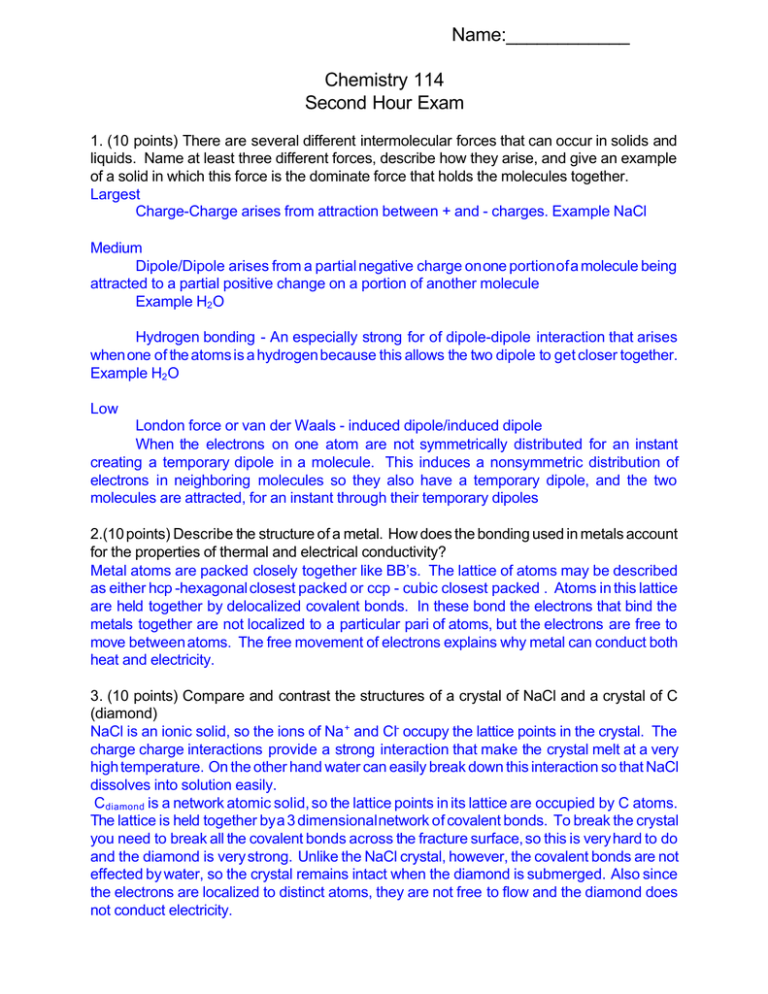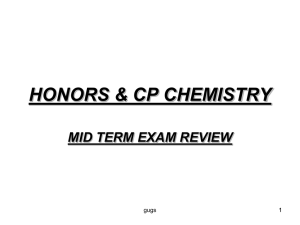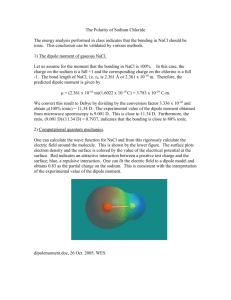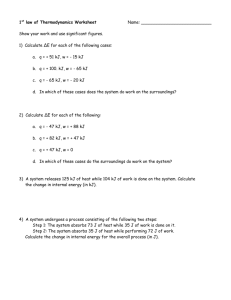Name:____________ Chemistry 114 Second Hour Exam
advertisement

Name:____________ Chemistry 114 Second Hour Exam 1. (10 points) There are several different intermolecular forces that can occur in solids and liquids. Name at least three different forces, describe how they arise, and give an example of a solid in which this force is the dominate force that holds the molecules together. Largest Charge-Charge arises from attraction between + and - charges. Example NaCl Medium Dipole/Dipole arises from a partial negative charge on one portion of a molecule being attracted to a partial positive change on a portion of another molecule Example H2O Hydrogen bonding - An especially strong for of dipole-dipole interaction that arises when one of the atoms is a hydrogen because this allows the two dipole to get closer together. Example H2O Low London force or van der Waals - induced dipole/induced dipole When the electrons on one atom are not symmetrically distributed for an instant creating a temporary dipole in a molecule. This induces a nonsymmetric distribution of electrons in neighboring molecules so they also have a temporary dipole, and the two molecules are attracted, for an instant through their temporary dipoles 2.(10 points) Describe the structure of a metal. How does the bonding used in metals account for the properties of thermal and electrical conductivity? Metal atoms are packed closely together like BB’s. The lattice of atoms may be described as either hcp -hexagonal closest packed or ccp - cubic closest packed . Atoms in this lattice are held together by delocalized covalent bonds. In these bond the electrons that bind the metals together are not localized to a particular pari of atoms, but the electrons are free to move between atoms. The free movement of electrons explains why metal can conduct both heat and electricity. 3. (10 points) Compare and contrast the structures of a crystal of NaCl and a crystal of C (diamond) NaCl is an ionic solid, so the ions of Na + and Cl- occupy the lattice points in the crystal. The charge charge interactions provide a strong interaction that make the crystal melt at a very high temperature. On the other hand water can easily break down this interaction so that NaCl dissolves into solution easily. Cdiamond is a network atomic solid, so the lattice points in its lattice are occupied by C atoms. The lattice is held together by a 3 dimensional network of covalent bonds. To break the crystal you need to break all the covalent bonds across the fracture surface, so this is very hard to do and the diamond is very strong. Unlike the NaCl crystal, however, the covalent bonds are not effected by water, so the crystal remains intact when the diamond is submerged. Also since the electrons are localized to distinct atoms, they are not free to flow and the diamond does not conduct electricity. 2 4. (10 points) When I shine X-rays with a 1.54Å wavelength at a material, I get a reflection at 2 = 20.5 o. Assuming that n=1 in this experiment, what is the distance between atoms in my material. nλ = 2d sin θ 1(154 . A) = 2 X sin( 20.5 154 . A = 2 X (.3502) 154 . A = X 2⋅.3502) X = 2.199 A 5. (10 points) I have discovered a new compound called Zoid in my lab. It has the following properties: At 1 atm pressure it is a hard black solid between 0 and 100K, it is a soft gray solid between 100K and 200K, it is a blue liquid between 200K and 300K, and it is a gas above 300K. At 10 atm of pressure it is a hard black solid between 0 and 200K, the soft gray solid form does not occur, it is a blue liquid between 200K and 350K, and it is a gas above 350K. At 20 atm of pressure it is a hard black solid between 0 and 200K, the soft gray solid form does not occur, it is a blue liquid above 200K but as the temperature increases it gradually becomes a fluid which does not appear to be a true liquid or a gas. Make a phase diagram below that is consistent with this data. Point out any triple points or critical points that occur in your phase diagram. In this problem find the transition points first, then fill in lines that connect the transition points. If you have the transition points located correctly, then there are many different lines you can draw to connect the points. Some features I was looking for: 1. 2 different solid phases 2. a critical point located somewhere between 10 and 20 atm 3. A triple point located anytime you have 2 phases at a single point 3 6. Assume you have a saturated solution of sugar (sucrose C12H22O11). This solution has 200 g of sugar dissolved in 100 g of water. A. (5 points) What is the molality of sugar in this solution? Molality = moles solute/liter solvent moles solut = 200g/342 g/mol = .585 moles Molality = .585 mole/.1 kg = 5.85 m B. (5 points) What is the mole fraction of water in this solution? Mole fraction water = moles water/total moles moles water = 100g/18g/mol = 5.556 mole fration = 5.556/(5.556+.585) = .904 C. (5 points) Assume you are at sea level where the vapor pressure of water is 1 atm at 100oC. What is the vapor pressure of this solution at 100oC. Pressure = VP pure solvent × mole fraction solvent = .904(1atm) =.904 atm D. ( 5 points) Assume you observed that the solution of sugar and water did not get significantly warmer or colder when you mixed it , what does this tell you about the )H soln for this mixture. Based on this observation would you expect the actual vapor pressure of the solution to be higher or lower than the number you calculated above? If solution did not get hotter or colder, then )Hsolution .0, and if )Hsolution .0, then we should have very little deviation from Raoult’s Law, so the actual pressure should be very close to the pressure you just calculated 4 7. (15 points) The heat of vaporization of water at 25oC is 43.9 kJ/mol. Use the ClausiusClapeyron equation (given below) and water’s heat of vaporization to determine the boiling point of water in Spearfish, when the atmospheric pressure is .85 atm. ( ) ( ) ln Pvap ,T1 − ln Pvap,T2 = ∆ H vap 1 1 − R T2 T1 For one temperature I expected you to remember that water boils at 100oC, so that is where the vapor pressure of water is 1 atm. In that case: ln(1) − ln(.85) = 0 − (.1625) = 43900 1 1 − 8.3145 X 373 43900 1 1 − 8.3145 X 373 8.3145 1 .1625 = − .00268 43900 X 1 3.078 x10 −5 = − .00268 X 1 3.078 x10 −5 + .00268 = X −3 2.711x10 = 1 / X ; X = 1 / 2.711 x10 − 3 X = 368.9 K = 95.9 o K 8. (15 points) Due to our elevation water boils at a temperature of less than 100oC. Assume that water currently boils at 97oC, How much salt (NaCl) would you have to add to 1 liter of water (about 1 quart) to make it boil at 100oC. (The boiling point elevation constant for water is 0.51 oC@kg/mol) For Boiling point elevation : )T=Kbim )T=100-97=3 i for NaCl =2 3 = .51(2)X X= 3/(.51x2) X = 2.941 m 1 liter of water is 1kg so we need 2.941 moles of NaCl to make this boil at 100oC This is 2.941 X 58.55 g/mol or 172 g of NaCl or about .4 lbs of salt I think we can safely say that you don’t add salt to the water just to try to get the boiling point up to 100!




